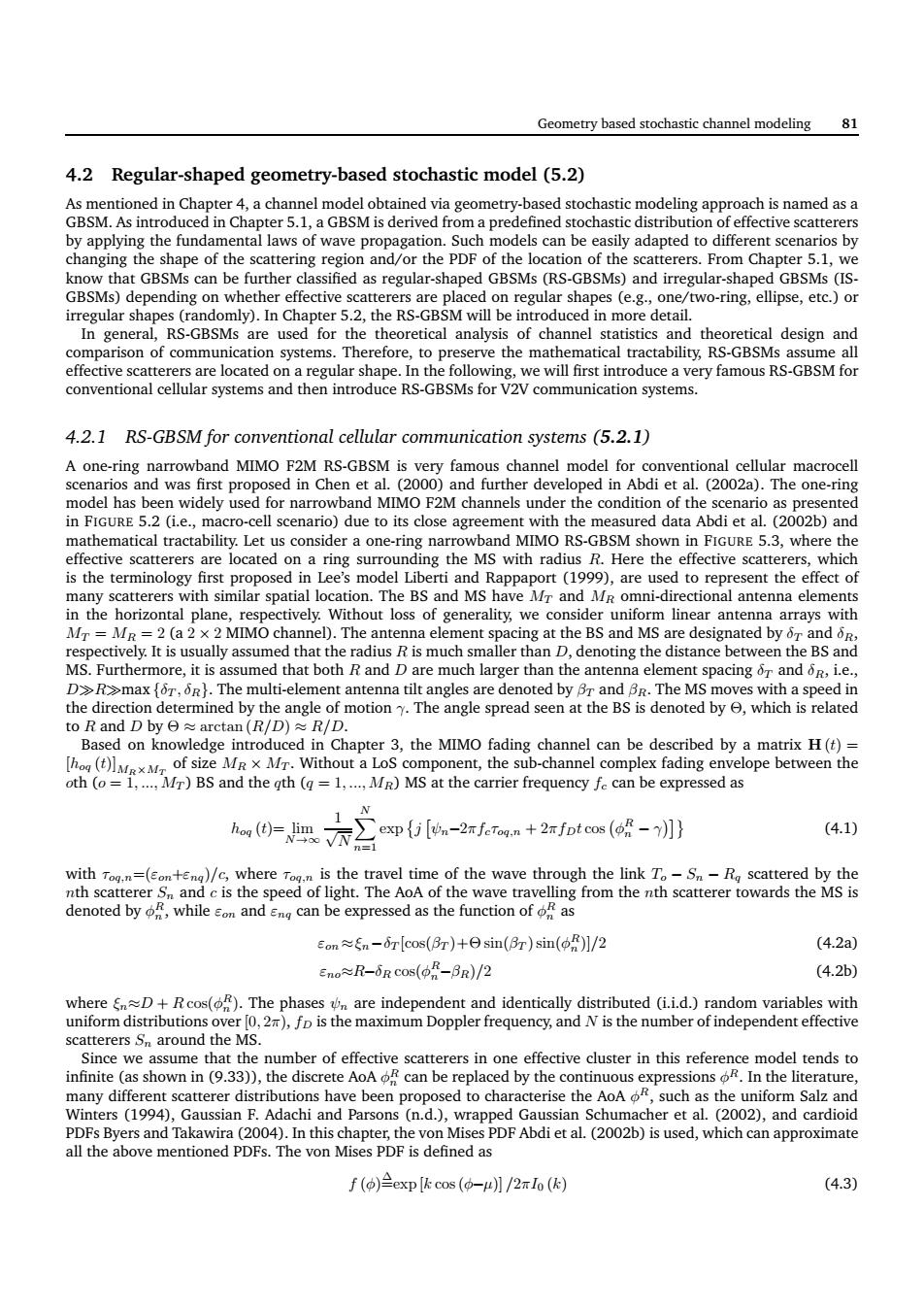正在加载图片...

Geometry based stochastic channel modeling 81 4.2 Regular-shaped geometry-based stochastic model(5.2) oach is named as a wthat GBSMs can be further Ms (RGBSMs)andreu-haped Med orh eoretical of hamnelch comparison of systems.T theonwewtduvry famouM 4.2.1 RS-GBSM for conventional cellular communication systems(5.2.1) Ae-ring narowband MIMO F2M RS-GBSM is very famous channel model forcoventional a macroce wband MIMO F2M chan of the The one-ring mathematical tractability.Let us consider a one-ring narro .3,where th the temino is much sma er than denoting the distance BS and max).The multi-element antenna tilt angles are denoted byr and .The MS moves with a speed in motion y.The angle spread seen at the BS is denoted by e,which is related -.不∑e即5-2m+2(-7川} (4.1) denoted bywhileandexpreedthectin of con~En-6r[cos(Br)+sin(Br)sin()1/2 (4.2a) EnoR-6Rcos(R-BR)/2 (4.2b) n7meaa ributed (i.id.)random variables with scatterers S around the M e)e odel tends to he p eee on Mise etud,which mate f()exp[cos(-p)]/2Io(k) (4.3)Geometry based stochastic channel modeling 81 4.2 Regular-shaped geometry-based stochastic model (5.2) As mentioned in Chapter 4, a channel model obtained via geometry-based stochastic modeling approach is named as a GBSM. As introduced in Chapter 5.1, a GBSM is derived from a predefined stochastic distribution of effective scatterers by applying the fundamental laws of wave propagation. Such models can be easily adapted to different scenarios by changing the shape of the scattering region and/or the PDF of the location of the scatterers. From Chapter 5.1, we know that GBSMs can be further classified as regular-shaped GBSMs (RS-GBSMs) and irregular-shaped GBSMs (ISGBSMs) depending on whether effective scatterers are placed on regular shapes (e.g., one/two-ring, ellipse, etc.) or irregular shapes (randomly). In Chapter 5.2, the RS-GBSM will be introduced in more detail. In general, RS-GBSMs are used for the theoretical analysis of channel statistics and theoretical design and comparison of communication systems. Therefore, to preserve the mathematical tractability, RS-GBSMs assume all effective scatterers are located on a regular shape. In the following, we will first introduce a very famous RS-GBSM for conventional cellular systems and then introduce RS-GBSMs for V2V communication systems. 4.2.1 RS-GBSM for conventional cellular communication systems (5.2.1) A one-ring narrowband MIMO F2M RS-GBSM is very famous channel model for conventional cellular macrocell scenarios and was first proposed in Chen et al. (2000) and further developed in Abdi et al. (2002a). The one-ring model has been widely used for narrowband MIMO F2M channels under the condition of the scenario as presented in FIGURE 5.2 (i.e., macro-cell scenario) due to its close agreement with the measured data Abdi et al. (2002b) and mathematical tractability. Let us consider a one-ring narrowband MIMO RS-GBSM shown in FIGURE 5.3, where the effective scatterers are located on a ring surrounding the MS with radius R. Here the effective scatterers, which is the terminology first proposed in Lee’s model Liberti and Rappaport (1999), are used to represent the effect of many scatterers with similar spatial location. The BS and MS have MT and MR omni-directional antenna elements in the horizontal plane, respectively. Without loss of generality, we consider uniform linear antenna arrays with MT = MR = 2 (a 2 × 2 MIMO channel). The antenna element spacing at the BS and MS are designated by δT and δR, respectively. It is usually assumed that the radius R is much smaller than D, denoting the distance between the BS and MS. Furthermore, it is assumed that both R and D are much larger than the antenna element spacing δT and δR, i.e., D≫R≫max {δT , δR}. The multi-element antenna tilt angles are denoted by βT and βR. The MS moves with a speed in the direction determined by the angle of motion γ. The angle spread seen at the BS is denoted by Θ, which is related to R and D by Θ ≈ arctan (R/D) ≈ R/D. Based on knowledge introduced in Chapter 3, the MIMO fading channel can be described by a matrix H (t) = [hoq (t)]MR×MT of size MR × MT . Without a LoS component, the sub-channel complex fading envelope between the oth (o = 1, ..., MT ) BS and the qth (q = 1, ..., MR) MS at the carrier frequency fc can be expressed as hoq (t)= lim N→∞ 1 √ N X N n=1 exp j ψn−2πfcτoq,n + 2πfDt cos φ R n − γ (4.1) with τoq,n=(εon+εnq)/c, where τoq,n is the travel time of the wave through the link To − Sn − Rq scattered by the nth scatterer Sn and c is the speed of light. The AoA of the wave travelling from the nth scatterer towards the MS is denoted by φ R n , while εon and εnq can be expressed as the function of φ R n as εon ≈ξn−δT [cos(βT )+Θ sin(βT ) sin(φ R n )]/2 (4.2a) εno≈R−δR cos(φ R n−βR)/2 (4.2b) where ξn≈D + R cos(φ R n ). The phases ψn are independent and identically distributed (i.i.d.) random variables with uniform distributions over [0, 2π), fD is the maximum Doppler frequency, and N is the number of independent effective scatterers Sn around the MS. Since we assume that the number of effective scatterers in one effective cluster in this reference model tends to infinite (as shown in (9.33)), the discrete AoA φ R n can be replaced by the continuous expressions φ R. In the literature, many different scatterer distributions have been proposed to characterise the AoA φ R, such as the uniform Salz and Winters (1994), Gaussian F. Adachi and Parsons (n.d.), wrapped Gaussian Schumacher et al. (2002), and cardioid PDFs Byers and Takawira (2004). In this chapter, the von Mises PDF Abdi et al. (2002b) is used, which can approximate all the above mentioned PDFs. The von Mises PDF is defined as f (φ) ∆=exp [k cos (φ−µ)] /2πI0 (k) (4.3)��